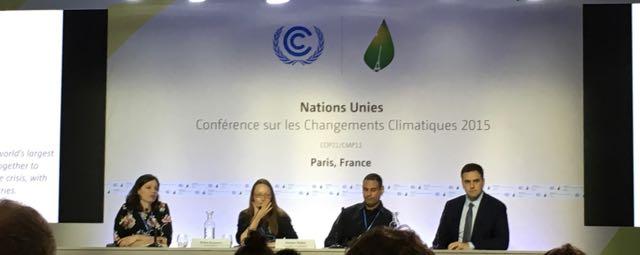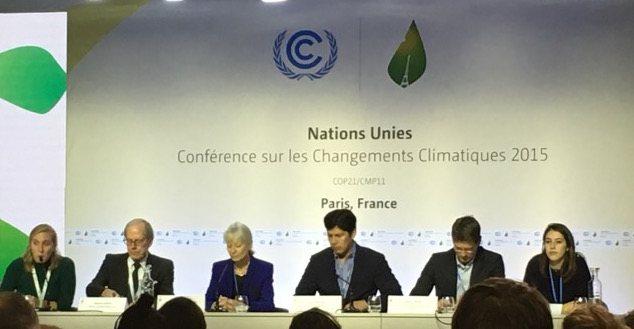COP21 Update: Revised Draft Text Agreement Released


A draft text for a global climate agreement was announced on Thursday morning at COP21, now slimmed down another four pages from the document sent to Paris in late October.
At a press conference on Thursday hosted by Climate Action Network International, Kaisa Kosonan of Greenpeace said that negotiations of the current ADP session has "made progress," especially on defining long-term climate and emissions goals.
Kosonan said that the concept of a 1.5.degree Celsius limit on global warming is gaining wider acceptance, especially after French president François Hollande mentioned it in his speech on Monday. Many leaders, particularly those of small island and other more vulnerable nations, maintain that the goal of 2-degrees Celsius rise over pre-industrial levels will burden their people with suffering and loss from the devastating impacts from climate change, for which they are largely not responsible.
Even if the climate pact endorses a 1.5-degrees Celsius limit, which is by no means certain, or even likely, many scientists say the world is already locked into 1.5 degrees, no matter what happens going forward.
Finance a "sticking point"
Given the potential climate impacts of even a 2-degree rise in global warming, the issue of loss and damage and climate finance continue to be a "sticking point," said Alex Doukas of OilChange International.
"There's a big gap between reality and promise," Doukas said
Citing the $452 billion global annual subsidies given to fossil fuel, Doukas said the "disparity" between developed countries' foot-dragging on climate finance is an unnecessary roadblock to resolving this issue. "Rich countries are speaking out of both sides of their mouth," he said, adding that they can not claim there is no money when it is readily available by shifting the subsidies that "drive the climate crises" to clean-energy development and climate finance for developing nations.
Differentiation vs. symmetry
Raman Mehta of the Vasudha Foundation mentioned talk in the negotiations for a new definition of "differentiation" among national responsibility and action, saying the current concept of bifurcation between rich and poor nations codified in the Kyoto Protocol has "outlived its usefulness."
Mehta cautioned that the idea of "total symmetry" between nations promoted by many in the developed world is "not appropriate" and "needs work at the "ministerial level." Acknowledging that the current pattern needs to change and all nations must do their part, Mehta says differentiation must include each country's responsibility and ability to respond to climate change.
The current COP negotiating session expires on Friday and is expected to be delivered to COP president Laurent Fabius by noon on Saturday.
Ministerial negotiations will begin next week.
Image courtesy of the author
The Global Food Waste/Energy Nexus: Is Buying Local Always the Best?


Most of us assume that it's better for the health of the planet if we buy our food locally. After all, those bananas we purchase each week travel many miles by ship to get to our breakfast table. And that chicken we bought for tonight's dinner most likely arrived courtesy of a lengthy supply chain across the country. So did the tomatoes that arrived from farmlands in Mexico.
But the fact is: Calculating the environmental impact of our food purchases isn't always as simple as figuring the driving distance to the nearest point. Rich Pirog, the senior associate director of Michigan University's Center for Regional Food Systems, is credited with helping to debunk that generalization.
According to his early research on the transportation impact of shipping perishable foods, the fact that food was shipped across the country or across the world doesn't tell the whole story when it comes to the environmental impacts of food shipments. The real issue, said Pirog, is the method that was use to ship the product: whether it arrived by air, by ship, by rail or by land. And even then, say some researchers, small-scale local production doesn't always win out over large-scale operations that have better transportation systems and food preservation methods at their fingertips.
Since Pirog's initial research in 2001, a plethora of studies were conducted on this subject, particularly when it comes to perishable foods that can't simply be crated and put on a ship or rail, like bananas can. Tomatoes that were grown in greenhouses in Sweden's variable climate actually required 10 times the energy usage than those shipped in from the sunny fields of Southern Europe. Similarly, researchers found that it wasn't the refrigeration or the fuel that was required to ship beef, chicken or eggs to supermarkets that hiked the carbon emissions, but rather the production and processing of fresh meats and eggs at the point of origin. When it came to meat products, transportation (including the refrigeration of the product) resulted in only about a 1- to 2-percent rise in energy costs. Fresh produce was the most expensive to transport at 11 percent.
And the process that is used for growing, and storing, produce weighs into that cost as well, as a 2008 study showed when the authors compared how apples are grown and handled in different countries. Apples that were lost in production from seasonal weather and other issues figured into the energy costs, as did the way they were farmed, how they were marketed and what methods were used in pest management.
Food loss and waste accounts for as much as a third of the world's production, but even adjusting our finicky eating habits can't erase the loss that comes when adequate protections aren't available or aren't used in distribution.
As much as 20 percent of the sub-Sahara's grain production is lost each year due to spoilage. When it comes to insufficient refrigeration and preservation in Latin American countries like El Salvador, Colombia, Trinidad and Belize, the Food and Agriculture Organization of the United Nations (FAO) estimates that if all food loss were eradicated, those countries would have enough food to meet their First Millennium Goal, a crucial consideration for food security in developing nations.
Here in the U.S., as much as 12 percent of retail food products is lost to spoilage or other issues on its way from the retailer to the consumer. But it is a small percentage when considering what goes into the dumpster once it is sold to the consumer. A whopping 28 percent is lost due to spoilage, waste and inedible material (stems, peelings, seeds or fruit membranes we were raised not to consume), after the perishable items leave the store with the consumer.
Pirog and other researchers point out that buying locally can have its benefits when it comes to slimming down the overall energy and emissions costs. Buying locally-grown fruit in British Columbia, Canada, for example, where a major agricultural industry makes it easy to purchase fresh apples from the local corner store, makes more sense, perhaps, than purchasing Washington or Japanese varieties. But with today's packaging and shipping systems geared toward expedited delivery and minimizing food loss, product refrigeration and preservation makes up only a small percentage of the energy that is spent in getting perishables to their destinations.
The real challenge, say experts, is retooling the way we look at the value of the food we purchase, and our collective part in ensuring a well-fed and sustainable planet.
Images: 1) Bob Shrader; 2) David Stanley; 3) Taz; 4) A Davey.
Firms Could Lose $2 Trillion on Unneeded Fossil Fuel Projects


The COP21 talks in Paris started this week, and the 12-day conference will be critical in nudging the world’s nations toward agreement on a binding plan to confront climate change and limit global warming to 2 degrees Celsius this century. Whether or not these United Nations-led talks succeed is a huge question, but trends underway reveal that the world is shifting toward a lower, if not low-carbon, economy.
Clean energy technologies are scaling and becoming more cost effective, and more governments and companies are acknowledging the risks climate change poses and are therefore developing plans to cope with an uncertain future.
With these changes in mind, the think-tank Carbon Tracker issued a report suggesting that energy companies that are investing in long-term fossil fuel projects may be putting themselves and their shareholders at financial risk. According to this report, The $2 Trillion Stranded Assets Danger Zone, energy companies worldwide are dismissing advances in technology and changes in policy — therefore exposing them to financial risk as an excess of energy supplies may never generate the financial returns promised to their investors.
Yes, that is 2 trillion with a “T,” and American energy companies would account for over 40 percent of those failed projects, with Carbon Tracker’s projection of $412 billion invested in unneeded projects in the U.S. alone. The energy sectors in nations including Canada, China, Russia and Australia could also suffer, based on Carbon Tracker’s global analysis of energy capital investment projections until 2025 and anticipated energy projection to 2035.
Carbon Tracker’s researchers examined recent events that broadsided the energy industry, along with what the organization forecasts for this sector in the coming decade. Last year presented many harbingers for a shifting energy scenario: the halving of oil prices in only six months; demand for coal in China peaking; weakened currencies endemic within most of the leading resource-exporting nations; and the cancellation or postponement of $200 billion in energy projects worldwide in 2015 alone.
This report also considers the potential growth of the fossil fuel industry while looking at why many projects worldwide may need to be axed in order to stay consistent with the International Energy Agency’s 450 Scenario, one of many suggested plans to limit global warming to 2 degrees Celsius by limited greenhouse gas emissions to 450 parts per million. In plain English, the future, suggests Carbon Tracker, is a bleak one for fossil fuel producers, starting with coal.
While some countries, including India and South Africa, may see some increased demand for coal, Carbon Tracker forecasts no need for new mines. Under the 450 Scenario, 90 percent of future unnecessary coal supplies would be concentrated in China, the U.S., Australia, India and Indonesia.
Meanwhile, the confluence of new technologies and policy will have an impact on the global oil and gas industry as well. Natural gas, according to this report, will see some growth, but at a lower level than most energy analysts have expected. Countries with domestic supplies will still see continued demand, but the capital-intensive liquefied natural gas (LNG) market will prove disappointing to investors. As for petroleum, Carbon Tracker insists demand will peak in 2020, contrary to what many oil companies have been stating publicly. With oil becoming more difficult and expensive to extract, especially supplies derived from offshore deposits, the reports analysts suggest anywhere from 20 to 25 percent of future oil projects will not be necessary.
So, is this wishful thinking on behalf of renewable energy advocates, or a fair warning to an industry that is unwilling to change its ways? The answer is most likely a combination of both.
It is true that that the world’s biggest energy producers (and depending on metrics used, energy consumers), including Canada, the U.S., Australia and China, have adopted new energy and climate policies that should give energy companies enough reason to take a step back and reexamine their strategies. Low energy prices have not slowed renewables’ momentum as they keep improving in performance and cost. But a growing population, not to mention a surging global middle class, could continue to provide a cash cow for energy companies.
A political shift could launch energy policy in a different direction, but at this point the only nation in which this could happen in the near-term is in the U.S. after the 2016 elections. Regardless, says Carbon Tracker, energy companies would be wise to set strategies that say within the IEA’s recommended carbon budget — or lose the confidence of investors who are increasingly aware of the fact that the business climate, just like the world’s climate, is changing.
Image credit: Leon Kaye
World Bank Announces New Carbon Pricing Initiative


By Michael Green
On Tuesday morning the World Bank, along with governments and business leaders, announced a new global initiative: the Carbon Pricing Leadership Coalition. Jim Yong Kim, president of the World Bank, announced the coalition in a statement. Highlighting the pros and cons, Mr. Kim said: “We ... recognize carbon pricing is not an easy policy to implement. Experience, though, shows us that it can deliver dividends.”
Economists and businesses have been discussing carbon pricing in the build-up to the COP21 climate talks, but a carbon fee might not be on the negotiating table. Christiana Figueres, executive secretary of the UNFCCC, has said that carbon pricing will likely not be included in the final climate agreement. “We already have a strong carbon price signal,” Figueres said.
Today, carbon pricing mechanisms already cover around 12 percent of total emissions, with 40 nations and 23 cities, states and regions participating. Even more countries and provinces are stepping forward with their own proposals. But the business community has a different perspective on the issue, with small business as well as some of Europe’s largest oil companies speaking out in support of stronger carbon pricing.
Why are businesses lining up in support of a carbon fee? They know that the world needs a plan to address emissions, and putting a price on carbon is not only cost effective, but also predictable. It sends clear price signals to industries, businesses and consumers about the real costs of climate change, giving them the opportunity and incentives to adjust to a low-carbon economy. A price on carbon provides a transparent and predictable path for investments that will help mitigate climate change.
In the United States, businesses have begun to band together in support for local and national carbon pricing efforts. States including Oregon, Washington, Vermont, New York, Rhode Island and Massachusetts have carbon pricing proposals. At the national level, U.S. Sen. Sheldon Whitehouse (D - R.I.) has proposed a U.S. economy-wide carbon fee.
“Revenue-neutral carbon pricing isn’t about growing the size of government. Nor does it involve direct regulation,” the senator said when reached for comment. “The idea is so ‘market-based. So, respectful of individual choice, it’s won the support of Greg Mankiw, chair of the Council of Economic Advisers under President George W. Bush and advisor to Mitt Romney during his 2012 presidential campaign.” State Sen. Michael Barrett (D - Lexington) is the sponsor of a carbon pricing proposal in Massachusetts. The proposal has seen wide business support from a diverse range of industries, including the financial sector, technology services, and construction.
To our north, the four most populous Canadian provinces by 2017 will all have some form of a carbon pricing scheme. British Columbia has had one in place since 2008 that has had astounding results, and Quebec in 2014 opted into the California cap-and-trade program. Canada’s most populous province, Ontario, announced this year that it will start its own cap-and-trade program. And even Alberta, home to vast amounts of tar sand oil, just announced its own economy-wide, revenue-neutral price on carbon.
But critics of carbon pricing have concerns over its practicality. For one, calculating an exact price for emissions is complicated. It requires complex environmental and economic models that need to be constantly updated to reflect new information. The countries and businesses use a wide array of estimates: Sweden put it at $168/ton; the U.S. government estimate is $38/ton; and Exxon-Mobil uses $60/ton.
This is why economists suggest a more general approach. Models can assess how a particular price can affect global emissions. Therefore the strategy is then to identify a temperature target and use the price that would reach that goal. But the only way this can be done is if world leaders come together and decide that they want carbon pricing on the table.Carbon pricing makes sense: It is a simple mechanism that both businesses and consumers can understand. We are still going to need investment and commitments, technology transfer, and a global dialogue to reach our goals. But If we as a global community are going to keep global temperature rise below 2 degrees Celsius, then we need drastic action. A carbon price is not projected to get us all the way there, but it is the single best step we can take towards a climate change free future.
Image credit: Flickr/Moyan Brenn
What are the Perspectives of Developing Nations at COP21?


By Averill Brewer
There is no one-size-fits-all when it comes to climate change solutions. The last century-and-a-half has been filled with progress, but the repercussions of the industrial revolution on our climate will take many years and many billions of dollars to mitigate on a global scale. The leaders of developing countries will possess some of the most interesting perspectives to observe at the 2015 U.N. conference on climate change in Paris this week, as they must delicately balance the need to bring hundreds of millions out of poverty while also consciously developing their own paths for mitigating their impacts on climate change.
The Guardian reports that one of the most vocal and passionate groups at the Paris conference so far is the Alliance of Small Island States (AOSIS) who are the “most at risk from climate change” and are urging major players like the “U.S., China and Europe to set a long-term goal of 1.5 degrees Celsius,” versus the 2 degrees Celsius temperature change called for by climate scientists. The history of the 2-degrees Celsius equilibrium was set by the EU in 1996 as a ceiling based on scientific evidence that, if the average global temperature rises 2 degrees C above pre-industrial levels, then severe climate change impacts will increase exponentially.
Although climate change is not a competition of who will be the most affected by its impacts, tension must exist between rich, industrialized countries and developing countries, who are still seeking to give access to the billions at the bottom of the ladder needing basic necessities like electricity.
The New York Times reported that on Monday, in a speech at the Paris conference, Chinese President Xi Jinping conveyed the need to “respect differences amongst countries, especially developing,” and addressing climate change “should not deny the need of developing countries to reduce poverty,” perhaps signaling that in order to do so (reduce poverty), more pollution and consumption of coal and oil will take place. President Xi Jinping also conveyed that countries must retain the ability to “pursue their own solutions to climate change and that there should be an emphasis placed on continued dialogue and the exchange of best practices for mutual learning amongst countries.”
If rich countries have historically been the largest emitters of CO2, the second half of the century saw the emergence of China into the CO2 big-emitters club. With China’s new status as the world’s largest economy, or second largest depending on your source, one important factor to note is that 82 million people still live below the poverty level in China. How does this translate? 82 million people, plus the hundreds of millions in other developing countries, will have the pleasure of eventually being able to consume at levels they have yet to experience: buying cars, gadgets, clothes, food et. al.
Rich countries pledged $100 billion at the Paris conference to help poor countries combat the climate change that the rich countries are largely responsible for (see above). President Xi Jinping believes more funds are needed to provide for poorer nations, but is China now considered a “rich” nation?
Indian Prime Minister Narendra Modi conveyed that raising the standard of living for the impoverished in India without breaking the carbon budget will be a central challenge to the country, the Wall Street Journal reports. India’s minister of state for environment, Prakash Javadekar, thinks that developed countries must “accept historic responsibility of polluting earth in search of development” and must “walk the talk” to make the climate change conference a success, according to the India Times. Javadekar also said that a key contribution to helping developing countries like India combat climate change will be funding technology transfers with respect to intellectual property rights.
Ultimately, the “world’s billions are at the bottom of the ladder and are seeking growth,” said Prime Minister Modi, as quoted in the Hindustan Times. He believes “rich nations need to do more to fight climate change and provide enough ‘remaining’ carbon space to the developing world to grow and meet aspirations of billions living in poverty”; i.e. rich nations, here’s some food for thought: Don’t hog the carbon space pie, please!
Image credit: UN Climate Change Conference
Averill Brewer is a writer currently living in England. This autumn she completed her master’s of international business with a focus in sustainable development. In her free time, she writes for her blog www.locoeco.com. You can contact her at [email protected]
REDD Offsets in California?


By Mik McKee
In late October, the California Air Resources Board (ARB) held a public workshop to present a white paper discussing the possibility of including international sector-based offsets in California’s cap-and-trade program.
While the white paper was the work of ARB staff, it was developed in consultation with the Governors’ Climate and Forests Task Force (GCF) — a group comprised of 29 different subnational jurisdictions, including states and provinces from Brazil, Indonesia, Mexico, Spain, and the United States, among others. The primary focus of the paper was to assess and provide recommendations for how carbon offsets generated through the United Nations’ initiative on Reducing Emissions from Deforestation and forest Degradation (REDD) could meet emissions reductions targets established by California’s Global Warming Solutions Act of 2006 (Assembly Bill 32 or AB 32).
While ARB has not yet approved REDD or other international sector-based offsets for use to meet compliance obligations under AB 32, ARB staff have presented a compelling argument for why REDD offsets should be allowed for the third compliance period starting in 2018.
Perhaps most persuasive, given the ongoing 2015 Paris Climate Conference (COP21), is that California has established itself as a leader in combating climate change. Additionally, as the more than 195 international parties attending COP21 demonstrate, climate change is a global problem. ARB staff therefore suggest that approving REDD offsets not only perpetuates California’s leadership role, but also that REDD offsets increase the state’s impact by incentivizing carbon sequestration on a global rather than national scale.
The second compelling point made by ARB staff is that REDD offsets will provide a cost-effective option for entities required to meet the emissions cap. A year ago this argument may not have stood up. However, in 2015 the price of California Carbon Offsets (CCOs) has steadily ticked up to the point where they are now only 8 to 10 percent below the price of Allowances. This situation is potentially compounded by the fact that some carbon analysts predict there will be an offset shortage in the near-term.
This is somewhat of a nuanced argument because many (author included) believe the price of carbon is too low. Indeed, the U.S. Environmental Protection Agency places the 2015 social cost of carbon, which is essentially the price society will pay for inaction, at $40 per metric ton of CO2. Furthermore, higher carbon prices would lead to greater market participation resulting in additional co-benefits beyond carbon sequestration.
However, the long-term success of offset programs like AB 32 also depends on a certain level of price confidence. If demand and supply do not grow rationally, the result could be a catastrophic end to the market, similar to what happened with the Chicago Climate Exchange.
The challenge before ARB staff is to ensure that international sector-based offsets meet the same standards as California Carbon Offsets. Ultimately, three main tests lie before ARB staff: First, ARB staff must be certain that REDD projects sequester carbon beyond business as usual; second, REDD offsets must truly be quantifiable; and third, participating jurisdictions must be able to ensure that these offsets meet permanence requirements.
If ARB staff cannot prove beyond doubt that REDD offsets are real, additional and permanent, approving REDD offsets will undermine the integrity of California’s cap-and-trade program. However, tropical forests provide innumerable benefits, including being one of the world’s greatest carbon sinks. If the inclusion of REDD-based offsets in California’s cap-and-trade program leads to greater protection and improved management of these forests, the benefits will be global.
Image credit: Flickr/picccus
Mik McKee is the Senior Forestry Analyst for The Climate Trust.
As Industry Commits to Climate, a Level Playing Field is Needed


By Heidi Brock
As the global community convene in Paris to finalize a lasting agreement tackling climate change, one thing is clear: It will take a steadfast commitment from companies, industries and governments in order to ensure that the agreement is a success. That is why businesses across the globe have been striving to do their part to reduce greenhouse gas emissions and transition to a low-carbon economy. But that is also why we must call attention to individual country actions that undermine broader international efforts on climate in order to gain economic advantage.
As president and CEO of the Aluminum Association, I am proud of the work our industry has done to reduce its impact on the environment. North American aluminum’s carbon footprint has fallen by 37 percent since 1995 and achieved a 26 percent reduction in energy intensity over the same time period. We also know that aluminum can improve the environmental performance of other products through lightweighting and recyclability advantages. As I like to put it: Aluminum turns good products into great products.
In the United States, the aluminum industry has been and will continue to work hard to reduce the climate impacts of our industry. But we operate in a global market, and now we are faced with challenges from overseas producers who may not share the same commitment to environmental stewardship.
Recently, I was in China, speaking at a China Aluminum Week meeting on these very challenges. With industrial consumption slowing down at home, Chinese aluminum makers, enabled by government policy, are moving product out into the global market, including the United States. In addition to some concerning and questionable trade practices, this behavior presents serious environmental problems.
Aluminum production in China is the most carbon intensive in the world, with its coal-based smelters emitting significantly more greenhouse gases per ton of aluminum than its North American and European counterparts. In fact, a ton of aluminum produced in China is nearly twice as carbon-intensive as that same metal produced here in North America. Given the rapid expansion of high-carbon aluminum production in China, many of the efficiency and emissions reduction gains made by the global aluminum industry over the last several decades are being offset.
While we welcome healthy competition, industry growth and fair trade, we don’t want it to come at the cost of the progress being made on climate change and the environment.
In the long run, China’s government policies that permit and even encourage the perpetuation and expansion of high-carbon production do not benefit the global aluminum industry. They undercut efforts across the globe to promote positive attributes of aluminum and its value to a more sustainable environment and economy.
In addition to capping coal consumption as part of a comprehensive greenhouse gas emissions reduction plan with the U.S., China should set a specific goal to limit and reduce CO2 emissions from aluminum production, and include a robust verification process. This will limit pollution in China while leading to an overall reduction in global greenhouse gas emissions.
Having our governments say they support reducing carbon emissions is not enough. In this case, action is required. And these actions will only be recognized with verification. Without action, and without verification, our long-term global growth could be severely compromised.
In the United States, the aluminum industry is working to do its part. But challenges associated with climate change are global -- every nation and every industry must contribute. If we can work together to set common standards and ensure a level playing field that incorporates environmental considerations, then we can all benefit from a vibrant, sustainable global economy.
Image credit: Flickr/Ishikawa Ken
Heidi Brock is the President & CEO of the Aluminum Association, based in Arlington, VA. The Aluminum Association represents 111 U.S. and foreign-based companies and their suppliers throughout the value chain, from primary production to value added products to recycling.
For more information visit www.Aluminum.org, on Twitter @AluminumNewsor Facebook.com/
Record $3.4 Trillion Committed to Fossil Fuel Divestment


At a press conference on Wednesday at COP21 in Paris, representatives from the Rockefeller Brothers Fund, the California Senate, the World Resources Institute and the London School of Economics joined 350.org to announce that $3.4 trillion in assets are now committed to some form of divestment from fossil fuels.
May Boeve, executive director of 350.org, noted that some of that divestment is partial, divesting only from coal, oil, natural gas or some mix of the three, while other commitments are total divestment from all fossil fuels. With varying degrees of disclosure, the actual amount of money divested is difficult to track, but organizations pledging either partial or total divestment represent $3.4 trillion in assets under management.
Steven Heinz, president of the Rockefeller Brothers Fund, commented on the extraordinary acceleration of the movement in the 14 months since the fund announced its divestment plans in September of 2014, from $50 billion to $3.4 trillion.
Heinz attributes the expansion of divestment not only to its "moral imperative," but also to the "economic rationality" of risk management -- pointing to the growing number of pension funds, banks and other financial institutions increasingly divesting their portfolios away from fossil fuels.
Kevin De Leon, the president of the California senate, said that, as the seventh largest global economy, California's move from fossil energy investment and generation proves that decoupling works, citing the state's economic growth and shrinking emissions.
DeLeon sponsored Senate Bill 185, targeting $500 million for divestment in the state's pension fund. The legislation follows on the 2007 mandate from the California Energy Commission barring municipal utilities from operating any coal-fired power plants.
Pascal Canfin, former Development Minister of France and senior advisor for international climate affairs at the World Resources Institute, said the growing momentum in fossil fuel divestment rests on three pillars: ethics, financial pragmatism and regulatory framework reform.
Fund managers are required to disclose risk, Canfin said, and increasing "risk of liability" in fossil fuel investment creates a strong "incentive to divest."
Several new commitments surrounding divestment were announced today at COP21, including:
- 19 French cities have endorsed divestment ahead of COP21: 350.org will announce for the first time that it has secured commitments from 19 French cities, including Lille, Bordeaux, Dijon, Saint-Denis, Rannes, Ile-de-France and others.
- The French parliament has endorsed divestment: On Nov. 25, the French National Assembly adopted a resolution encouraging public investors, companies (especially those in which the state owns shares) and local authorities not to invest in fossil fuels anymore. The resolution is the first step to formalizing the policy as law.
- The French Ensemble Foundation will join European Divest-Invest: Jacqueline Délia Brémond, co-founder and co-chair of the French Ensemble Foundation, will announce that the foundation will join the European Divest-Invest initiative and divest its holdings from fossil fuels. Since 2004, the foundation has given over $28 million to environmental causes around the world.
Some of the most notable new announcements since Sept. 21 include:
- Uppsala became the largest city in Sweden to endorse fossil fuel divestment.
- Münster became the first city in Germany to divest completely from fossil fuels.
- Melbourne, the capitol of Australia, committed to go fossil-free ahead of COP21. In fact, Australia has seen a seven-fold growth in the divestment movement, from two councils divesting in 2014, to 14 divesting as of now. Together, these funds represent AUD$5.5 billion in assets under management.
- Oslo, the capitol of Norway, announced that it will divest its $9 billion pension fund (€8 billion) from coal, oil and gas companies, becoming the first capitol city in the world to ban investments in fossil fuels.
- Dutch pension fund PFZW announced it will divest from coal companies and reduce its investments in other fossil fuel companies. The fund has €161 billion of assets under management.
- The London School of Economics, one of the preeminent economics schools in the world, dropped all of its direct and indirect holdings of coal and tar sands, and all direct holdings of fossil fuel companies.
- Allianz, Europe’s largest insurance company, divested €630 million of its own capital investment portfolio from coal, and is reinvesting over €4 billion into wind energy over the next six months. This is one of the largest funds to make a commitment to divest from fossil fuels. Allianz tied its announcement to COP21, making the moral and economic case for investing in cleaner technologies
- APRA AMCOS, the biggest music industry organisation in the southern hemisphere, announced that it is beginning the process of divesting from all fossil fuels. APRA AMCOS distributed over $250 million in royalties to its 87,000 songwriter and composer members last year, making it a large cultural force for divestment.
- The London Science Museum announced plans to dump Shell Oil as a sponsor, amidst controversy and public pressure.
- In addition to the London School of Economics, five universities from the U.K. took action: Oxford Brookes University, University of the Arts London, University of Surrey and University of Sheffield divested from all fossil fuel companies; Wolfson College (Oxford University) divested from coal and tar sands. Fund manager CCLA, which manages investments for Birmingham City University, Cranfiled University, Heriot-Watt University, University of Hertfordshire, University of Portsmouth and University of Westminster excluded coal and tar sands from its investments.
- The first church in Germany, the Protestant Church in Hesse and Nassau, managing €1.8 billion, committed to drop investments in coal, oil and gas, too.
- Two weeks ago, renowned economists Thomas Piketty and Tim Jackson wrote a letter in the Guardian, calling on investors to divest from fossil fuel ahead of COP21.
COP21 Challenge: The Climate Finance Gap


There is incredible optimism that the ongoing global climate talks in Paris will produce, finally, a strong climate agreement. That being said, there are still some serious barriers that need to be overcome, none more so than determining an equitable and transparent system for climate finance.
Why finance matters
Climate finance is, simply, figuring how how money will be distributed among countries around the world to ensure that we both mitigate emissions to achieve necessary greenhouse gas reduction, and also help poorer, more vulnerable nations adapt to the expected impacts of climate change.
Much rests on the ability of negotiators in Paris to figure climate finance. For example, no country may be more crucial to the success of the COP21 process than India. It is quickly becoming the next China, with a rapidly growing economy and rapidly growing emissions, currently ranked No. 5 in the world. India surprised many when it released its climate plan ahead of COP, with ambitious national goals including a goal of 40 percent non-fossil fuel energy by 2030. But this plan is contingent on a single factor: $2.5 trillion in global climate finance. Without international assistance, India will not embark on a cleaner path, and all the hopes of a global agreement coming out of COP21 will be doomed to failure.
India's argument is quite clear – they, and many developing countries across Asia and Africa, did not cause this problem. Historically, they are responsible for just a tiny share of the greenhouse gases that are fueling global warming. Why should they have to pay to mitigate emissions when they still have hundreds of millions in poverty?
Thankfully, there is strong sentiment that industrialized countries using fossil fuels must put in sufficient funds to help emerging countries both adapt to climate impacts, and move technologically toward low-carbon growth. The problem is that the mechanism for ensuring that these funds are both sufficient and equitably-distributed is still lacking.
"Wealthier, developed countries are coming forward with finance – but the finance they have committed, especially finance for adaptation, is not enough. We need a concrete plan so they can fulfill this commitment they made," said Samantha Smith, with the World Wildlife Federation's Global Climate and Energy Program.
For example, at a previous COP meeting in Cancun, Mexico, industrialized countries including the United States agreed to set up a Green Climate Fund that would, annually, provide $100 billion to developing countries to meet the challenges of adapting, and expanding, renewable energies. Five years later, and it is still uncertain how we will meet that goal by 2020. One of the key key discussions in Paris will be ensuring that the fund reaches its goal.
Adaptation vs. mitigation
Another issue is determining how to distribute this fund between the two key facets of climate – mitigating emissions and adapting to the climate change that is both expected, and in many parts of the world, already being felt.
There is a disproportionate amount of global funding going to mitigation. Part of this is being driven by the market. The rapid drop in prices for renewables has increased private-sector investment in green energy around the world as it becomes more financially sound. It is something we talk about quite often at TriplePundit – business going green just makes financial sense.
But, on the flip side, adaptation is much more difficult to make a business case for. There is a huge upfront infrastructure cost, and returns are distributed and hard to quantify. Yet, for the millions living along vulnerable coastlines in Bangladesh, the Pacific Islands or even Miami, this is a real threat that needs urgent attention. Otherwise, the world could see a massive rise in climate refugees that would dwarf the current crisis in Europe.
"Less financially-developed countries will continue to need technical and financial support from both the public and private sectors to meet the significant challenges they face," said Josh Sawislak, global director of resilience for AECOM, and a former member of the White House Council on Environmental Quality.
This will likely be the most contentious issue in Paris, one that could unravel the talks. It also makes it clear that COP21 will not be the end-all solution. It is a chance for the world to come together and set up a framework to finally begin tackling, head on, the greatest challenge of our generation. Key to that will be figuring out how to integrate climate finance into the next climate treaty.
Image credit: Wikimedia Commons
Germany and the Netherlands Tackle the Risk of Rising Water


In today’s world, we need innovative solutions to help us anticipate complex demands across the globe. Water is strongly linked to global socioeconomic development, ranging from basic water safety, water quality and sanitation, to food supply and generation of renewable energy. The interwoven nature of these issues presents us with an ongoing challenge: to create feasible, smart and sustainable water solutions.
For centuries, Hamburg, Germany, and Rotterdam, Netherlands, have subsisted under the threat of rising sea levels, storm surges and floods. Now, as the water continues to rise, German and Dutch planners and engineers are forced to discover innovative ways to make these cities more resilient. They are experimenting with new ideas that fortify coastlines at lower environmental costs and learning valuable lessons that can be applied to vulnerable urban areas around the world.
Residents of these two great port cities have battled water since settlers first arrived centuries ago. Over the years, floods have destroyed property and, at times, drowned hundreds of people. Out of their ruins, these vulnerable cities have learned how to cope with the ever-present risk of flooding, and emerged as leaders in flood-control strategies and expertise.
Hamburg: Flood prevention innovation
Hamburg hosts Germany’s largest port, and is named the country’s “Gateway to the World." Europe’s second largest port, Hamburger Hafen, sits in an inland delta of the Elbe River, 110 kilometers (around 62 miles) from the North Sea.
When a very strong wind from the North Sea pitched a tide almost 18 feet higher than normal on Nov. 9, 2007, it sent a surge of water that rushed all the way to Hamburg, 56 miles inland. The port closed and a torrent washed through low-lying areas, wreaking havoc on homes and local businesses. However, one neighborhood, HafenCity, stayed nice and dry due to an innovative flood prevention program.
About 20 years ago, city officials realized that the islands, which were then an industrial district near the city center, could be put to better use. But before the idea could be realized, storm tides flooded the islands. Instead of ringing their 6 miles of shoreline with dikes to hold back the water, planners created a special development zone.
They demolished the old buildings and built new ones, with a new set of flood-related rules. The city built roads and open public spaces 25 feet above normal high-tide and waterproofed all of the structures. From being a city on the easternmost edge of the Western World, it has become the metropolitan heart of a continent growing together again, and a place with enormous potential.
By elevating the buildings on plinths made of mounds of compacted fill (warften in German), it has been possible to connect HafenCity with the existing city area and develop it step-by-step from west to east, and from north to south. All new buildings stand on artificial bases well above sea level -- out of reach of the most extreme flooding.
Rotterdam: Beyond barriers
As with Hamburg, a catastrophic flood also reshaped Rotterdam. On Jan. 31, 1953, a powerful storm struck the Netherlands, swamping nearly 340,000 acres of land and killing 1,800 people. This disaster compelled the Dutch government to design Delta Works, an initiative designed to protect areas that flood regularly from rising water.
In addition to reinforcing thousands of miles of dikes lining flood-prone rivers, this plan called for building robust dike-rings around large territories encircling Rotterdam, Amsterdam, and other urban areas, damming the bays with huge flood gates.
When a storm surge reaches 9.8 feet above normal sea level, two massive doors swing on pivots from opposite shores, meeting mid-stream like hands clasping. The Maeslant Barrier, a movable gate at the mouth of the Rhine River, is among the largest moving objects on Earth, each door being 787 feet long and weighing 15 million pounds.
As impressive as it sounds, this colossal flood gate did not come without a cost to the environment. It has been said to have caused serious ecological damage to the coast. “The technological approach has not brought us a sustainable solution,” explained Jan Mulder, a coastal engineer for a big Dutch water consulting firm, Deltares.
The barrier completely cut off three branches of a large estuary from the sea, transforming them into artificial freshwater lakes. It has seriously degraded nearby wetlands, algal blooms have plagued the water bodies and the fish, shellfish, and marsh grass that lived there have also disappeared.
The future of coastal cities
In the coming years, many more cities will take up the struggle that has preoccupied Hamburg and Rotterdam for more than 1,000 years. Last year, the U.S. Department of Housing and Urban Development revealed six plans for protecting the New Jersey and New York shores from storms like Hurricane Sandy, and allocated $2.5 billion in initial funding. Five of the funded projects — which included the use of dikes, rejuvenated marshes to slow storm surges, and natural basins for temporary storage of storm waters — were submitted by groups that included Dutch engineering and design firms.
While Germany, the Netherlands, the United States and other industrialized nations have the means to confront, if not overcome, rising sea levels, countries in the developing world — from Cairo to Bangladesh — generally do not. And one of the most important discussions taking place at the United Nations climate talks in Paris will be exactly how much aid industrialized nations will provide poorer countries in their battle to tackle rising sea levels.
However, despite the number of exciting innovations in this area, some people believe that a coastal retreat is inevitable. “Fighting water is a war you never win,” argued Henk Ovink, special envoy for international water affairs for the Netherlands. This is especially true today considering that global sea levels are projected to rise at least three feet this century. “Societies all over,” Ovink continued, “have to rethink."
Image credits: 1) Flickr/Giorgio Tomassetti; 2) Flickr/Thomas Wensing; 3) Flickr/Moyan Brenn